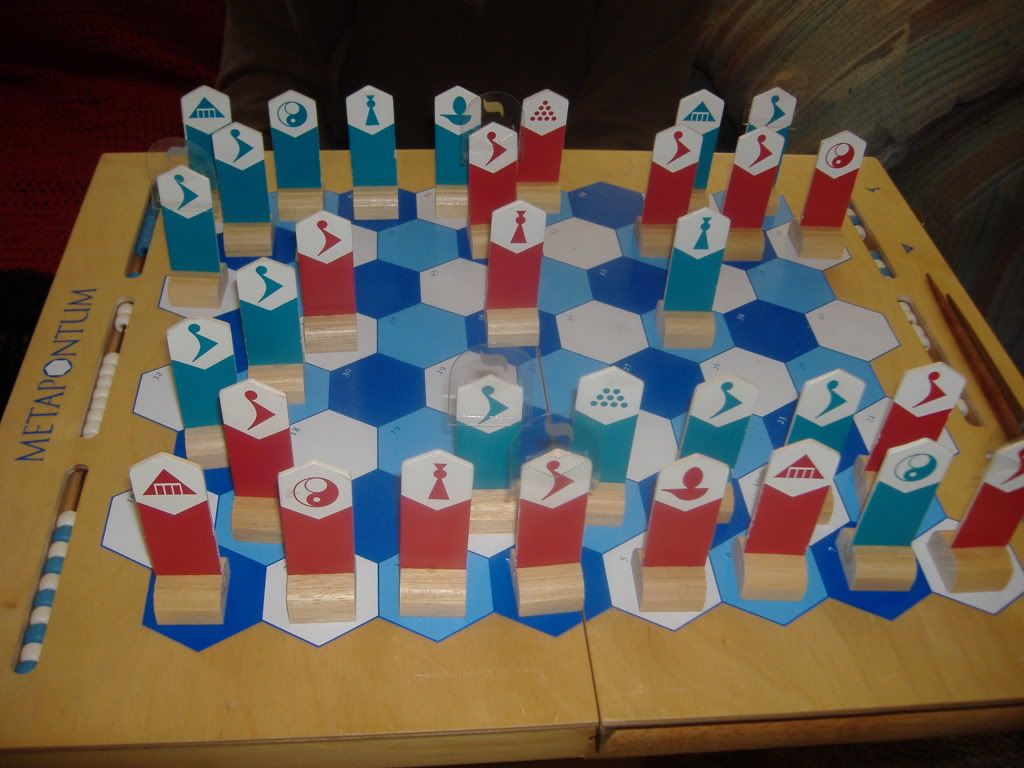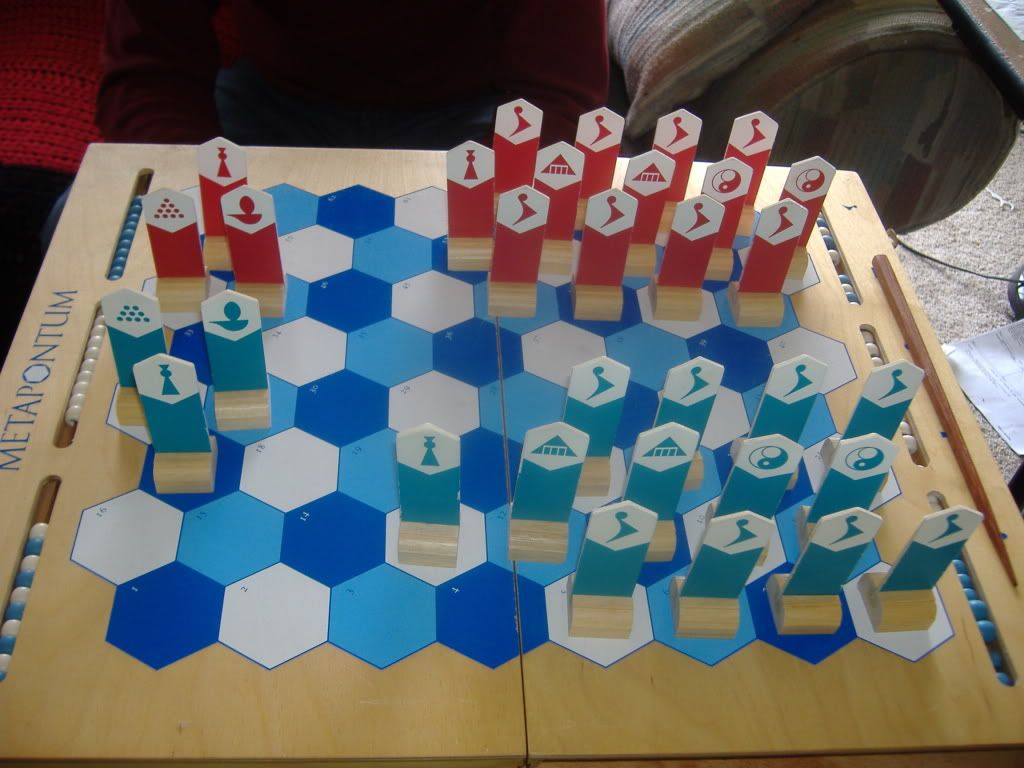I was sent a demo of Metapontum by its inventor, Hans Theo Frenkel, for review. I got the wooden version of the board with cardboard and wooden pieces, which have the icon of the piece printed on both sides for easy identification (a fact which I liked, since the board is always crowded in Metapontum). Some parts of the board were broken, but they were not relevant to the game as far as I could tell, so this was not a problem at all.
As I explained on the Metapontum page, Metapontum is a cooperative game played on an 8x8 hexagonal board where the goal is to end up at a given end setup, starting from a given opening setup. To accomplish this goal, players can either move their pieces or exchange a piece of their with an opponent's, the latter being only possible if the player's piece could move to the other piece's square.
Players may promote each other's pioneers (the equivalent of the Pawn), turning them into laureates (the equivalent of the Queen). Any time a player helps one of the other player's pieces get to its correct position on the end setup, he gets an honor point. But a piece which is located at its correct position on the end setup is immobilized for the rest of the game. Furthermore, there are restrictions on how a duo of players can win the game: to end correctly, both players must have done the same number of moves, have the same number of honor points, and the same number of laureates.
 |
A Master Pi game during the
endgame (click to enlarge). |
I had read about the game beforehand, and mastered the Master Pi sample game. David Mustoe and I played through this game on two different days. On our first day, I showed David the piece movements, which are relatively easy to follow because each piece is similar to its Chess counterpart, in a hexagonal form. The rules are also relatively easy to follow once you've got a grip on them.
We then followed through the Master Pi sample game, and then played a game on the Master Pi setup. We had an easy enough time of it, although we did not play as elegantly as the sample game and ended up with a lot of left-over Pioneers on the left side of the board for most of the game. We then played a game on the Double Hexagon setup, which was very enjoyable. Although we played with mirrored moves the whole time because of the symmetrical setup, which made it seem a little redundant, it was still quite enjoyable because of the challenge involved. There was a lot of discussion between us trying to figure out our next moves.
This game is sort of a special case; since this was our first game session of a cooperative game, there was some discussion over whether this game would hold our interest. We've found that this has been the case. The games were long, mainly because it was our first time around. The fact that most pieces have many different lines of sight made for some interesting, deep moves.
We found that there was somewhat of a tradeoff involved in realizing pieces too early, as it both means less traffic and less opportunities to move other pieces forward.
 |
| The Olympic setup (click to enlarge). |
On a later day, we played three games, the first on the Olympic setup, the second as a random setup, and the third on the Four Circles setup. All three games were considerably more difficult than our first two. Our impressions of the game did not considerably change, apart from the rise in difficulty. Frenkel recommends random setups where pieces of either color can end up anywhere, but we tried a random setup where pieces can only end up on their player's side (green from 1 to 32, red from 33 to 64). This was very satisfactory, although there were little problems (such as the regents starting near the middle and being in the way), but those can always be ironed up.
One problem which we ran into, insofar as the more difficult setups went, is that the endgame must be very precise: the requirement that both players end with the same number of moves is especially difficult to fulfill. We have found that this has sometimes given us headaches on the harder setups. To ease the endgame a bit, I recommend that, if you're not counting moves, you follow the principle that if only laureates remain to be realized and your honor points and laureates are equal in number, the game is won; in theory, laureates can stall as much as possible, making a win inevitable, and this skips a lot of needless complexity. This is a somewhat less elegant solution, but will do for casual play.
Frenkel likes to compare his game with Chess, and there are obvious resemblances. However, because of the cooperative nature of Metapontum, it is rather difficult to compare the two. The rules of Metapontum are slightly more complex than those of Chess, because of the added factors of honor points and the end requirements, but those who know Chess will have little trouble getting into a game of Metapontum. On the other hand, difficulty cannot really be compared, since difficulty in Chess depends on the difference in skill between the players, while difficulty in Metapontum depends on the setup and players involved.
As for replay value, which is always a concern that people have about cooperative games: we will definitely play Metapontum again. Because of its similarities to Chess, this game leads itself equally well to new cooperative variants (or even to competitive ones, although this may not please Mr. Frenkel!). Metapontum should give a lot of joy to fans of abstract games, especially those just discovering cooperative abstract games.

